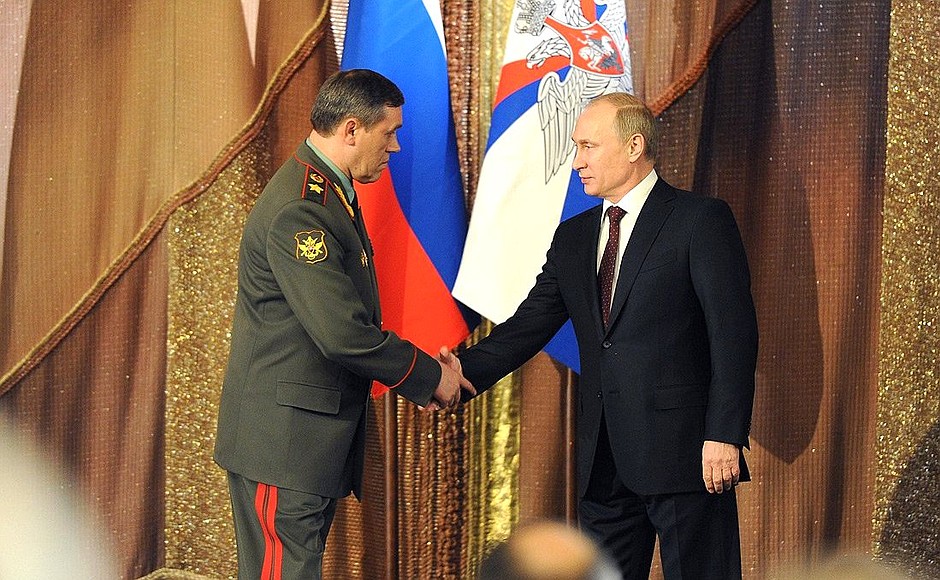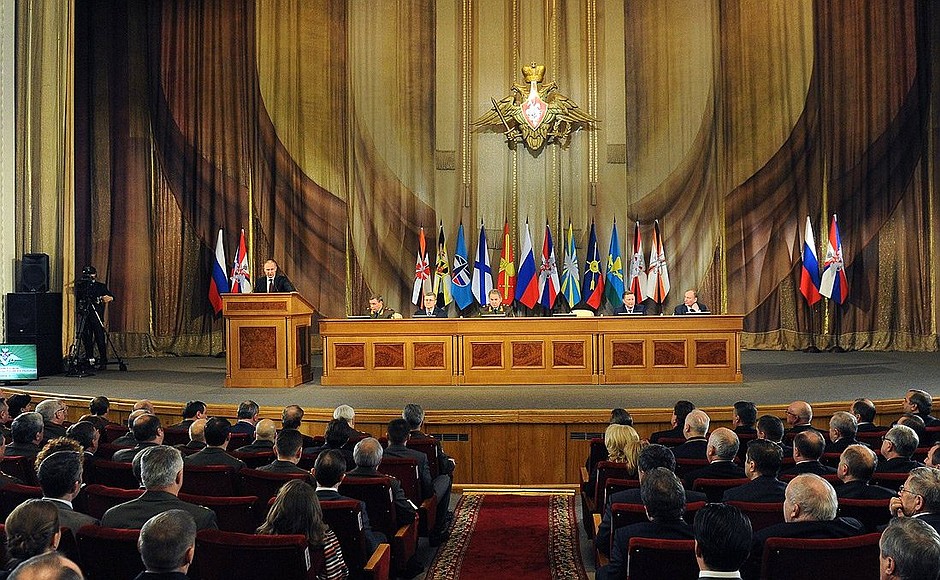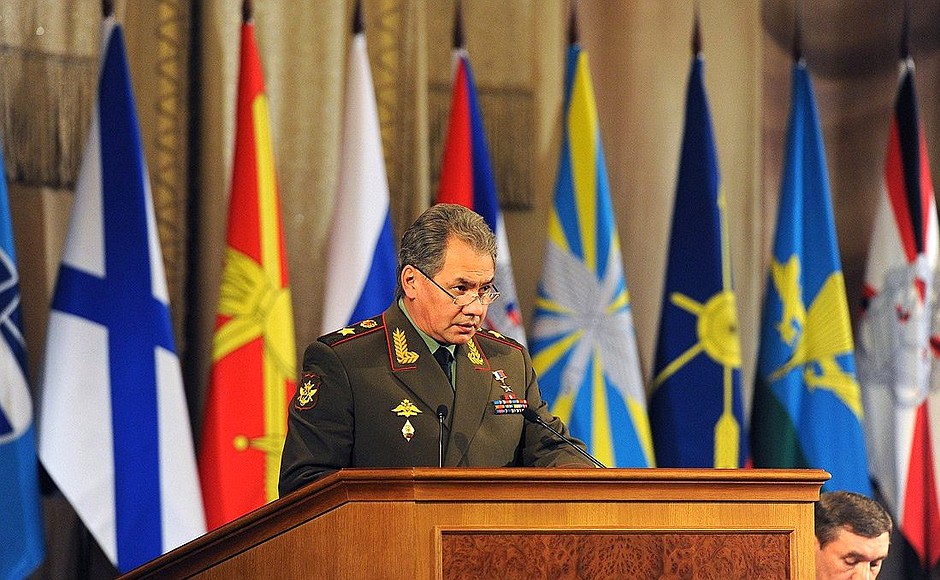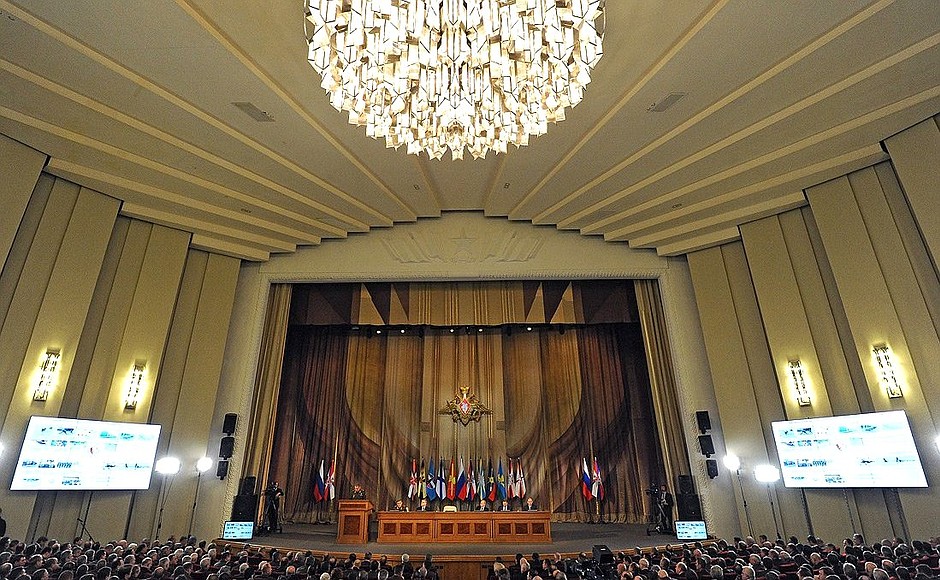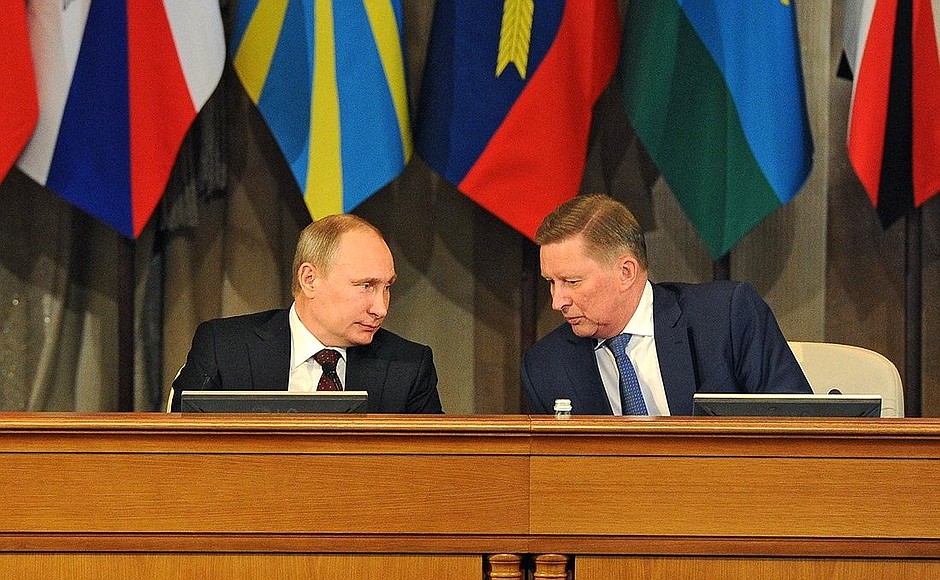Taking part in the meeting are chief commanders of the different branches and types of armed forces, the heads of the central military command bodies, and the command staff of military districts, fleets, groups and particular armed forces units. Representatives of the Presidential Executive Office, Government, Federal Assembly, a number of other federal government bodies, and veterans’ and public organisations are also in attendance.
By tradition the Board’s expanded meeting takes place at the General Staff Academy building in Moscow.
Mr Putin presented state decorations to a group of military personnel.
* * *
Speech at the expanded meeting of the Defence Ministry Board
President of Russia Vladimir Putin: Good afternoon, colleagues,
During the Board’s expanded meeting today, we will discuss what changes have occurred in the Armed Forces this past year and which short- and long-term plans must be implemented.
Russia consistently advocates resolving all regional and international issues exclusively by peaceful, diplomatic means. But I must say that, as previously, military deterrence continues to play a very important role.
We can see that the situation in some regions of the world is very difficult. Armed conflicts continue in several Middle Eastern countries. The upcoming withdrawal of international forces from Afghanistan in 2014 has the potential both to complicate the situation in that country and to create a significant zone of instability encompassing neighbouring Central Asian countries. This directly impacts on the Russian Federation’s national interests and our security.
We also know that most of the world’s leading countries are actively upgrading their military arsenals and investing huge sums in developing advanced weapons systems, including in those built with new generation technologies and according to new principles. Attempts to violate and disturb the strategic balance are ongoing; they are first and foremost related to US plans to build a missile defence system, including in Europe.
We must take into account all these potential challenges and threats our country faces, and work accordingly to further strengthen our Armed Forces.
I must say at once that a great deal has been done to this effect over the past year.
Six comprehensive combat-readiness snap inspections represented a serious test for the Armed Forces. For the first time, such inspections covered almost all different branches and types of armed forces throughout the country. In some cases, cooperation between the Army and federal and regional executive authorities was tested.
Of course, not everything is smooth here, not everything is as we would like, but the very purpose of such inspections is to identify weaknesses. This was accomplished, and conclusions were drawn. I very much hope and expect that all this will be integrated in further practical work. But overall, inspections uncovered positive trends in the military, and allowed us to assess realistically their capacities to solve challenges that were not known in advance, that suddenly presented themselves.
I would note the good organisation of the command and staff training exercises involving nuclear deterrence forces, which took place for the second time in modern Russian history. Land, navy and air forces successfully launched missiles and confirmed the reliability of Russia’s nuclear shield.
The combat capabilities of aerospace defence troops, especially the missile attack warning system, are improving. To date, this system covers all major missile-threat directions. Experts know perfectly well the problems in this field; we discussed them very recently in meetings with industry representatives. All are solvable and will be solved.
Our Navy has resumed a permanent presence in the Mediterranean Sea. During the past year all of our fleets made almost three times more trips into the Pacific Ocean than previously, and the number of regular long-range aviation flights increased too.
Special Operations Forces are being established to fight more effectively against international terrorism and to perform tasks outside Russian territory.
We witnessed good cooperation with our allies during the Russian-Belarusian Zapad-2013 strategic military exercises, as well as during drills and exercises involving units from a number of Collective Security Treaty Organisation (CSTO) and Commonwealth of Independent States (CIS) members. Together with our allies we can respond much more effectively to potential security threats and challenges, and we need to continually hone the mechanisms governing such coordination.
The military has been supplied with new equipment, and this implies important qualitative changes. Very few delays remain regarding deliveries of equipment to the ground forces. I expect that in the very near future all orders will be fulfilled, especially because at present defence companies are not only updating their base, but are working at a good tempo, and have amassed experience of large-scale production, something they did not have previously, and have not had for a long time.
Thanks to their constructive dialogue, Defence Ministry officials and defence industry representatives have managed to resolve many problems and establish good contacts between the industry and its customers. Of course, much remains to be done in this respect. First of all we need to work at lowering prices and reducing costs, as well as improving the quality and reliability of special equipment. We will go over all this during our practical work today.
I would remind you that within a year 30% of the Army’s equipment should be new and modern. In 2014, the Armed Forces should receive more than 40 of the most advanced intercontinental ballistic missiles, more than 210 aircraft and helicopters, and more than 200 armoured vehicles. Two nuclear-powered missile carriers – Alexander Nevsky and Vladimir Monomakh – will be deployed in the Navy, and six new satellites will join the existing satellite orbital group.
Along with this, the Defence Ministry must provide all necessary infrastructure for deploying this new technology. In other words, we all know that it’s possible to use this technology without the appropriate infrastructure, but to do so is expensive and wasteful. You need to do everything in twenty-first-century fashion, so that this equipment is in service for as long as possible, serves the people by ensuring our country’s security.
We must create an effective platform for expert training. In general, we should continue improving the content of combat training, including by continuing the practice of conducting comprehensive snap inspections of different formations and units; these must occur in all branches and types of armed forces and in all military districts. The outcome of such combat training will be the Vostok-2014 strategic exercises, which will focus on military security issues in the eastern part of Russia.
In 2014 we also need to finalise work to increase the numbers of Armed Forces personnel and reach staffing levels of 95 to 100%.
We must continue enlisting privates and sergeants under contract. This year they exceeded 200,000: the actual number is 205,100. As the results of drills and exercises demonstrate, a growing number of professionals significantly increases our troops’ combat readiness. That much is clear. The more complex the technology, the better trained the professionals who operate it must be.
In addition, next year we must finish establishing new formations and units that are part of the Armed Forces’ potential combat strength. Along with this I would ask you to pay special attention to the deployment of infrastructure and military units in the Arctic. I am going to talk about this in more detail now.
Russia is actively exploring this promising region, returning to it, and should use all possible channels to protect its security and national interests.
I would like to use this occasion to thank the staff and professionals who accomplished complex tasks this year: we re-established our military base on the New Siberian Islands, which are crucial for monitoring the situation throughout the Arctic. Let me also remind you that this year we began to re-establish northern aerodromes, as well as those in the Arctic region: Temp, Tiksi, Naryan-Mar, Alykel, Anadyr, Rogachevo and Nagurskoye. They are at different stages of development but have nevertheless been established. Before the end of the year we plan – and I count on it being done – to conclude state contracts for preparing design documents to develop and essentially to revive Tiksi aerodrome and carry out construction work on the Severomorsk-1 aerodrome.
Colleagues,
I want to particularly focus on reinforcing social guarantees for military service members and, first and foremost, this concerns housing issues.
In the last five years, the Defence Ministry has provided new housing to more than 162,000 military families. Of course, I know about the problems encountered during this work; there were many, but the work carried out was enormous. I want to stress once again, and you know it well, that never before has the government allocated this kind of funding to resolve housing problems for military service members – never.
We are now completing the construction of permanent housing for those who were put on the waitlist before January 1, 2012. As you recall, at the start of this year, there were 33,000 names on the list. Over the course of the year, we have been able to reduce the waitlist almost two-fold. We should provide housing to the remaining number of service members in this category – approximately 15,500 individuals – in the nearest future. Thus, we will settle our debts with regard to permanent housing. And I want to point out to the Defence Ministry and the Presidential Control Directorate that we need to monitor this situation. I said we are “settling our debts,” but we must be certain that the problem is really resolved.
Starting in 2014, the Defence Ministry must make a transition to a routine process for providing housing. We also need to use the savings and mortgage scheme options more actively. In the first eleven months of this year, Defence Ministry service members acquired nearly 12,000 apartments, while the total number of apartments since we launched this scheme back in 2005 is over 31,000.
Our next challenge is to create the service housing fund. This is, of course, a difficult challenge, and it must be fully resolved, taking into account the Armed Forces’ staffing level, as well as troops’ deployment locations.
We also need to further resolve long-standing problems, put military garrison towns in order, transfer the excess property released to Russia’s constituent entities and municipalities, and generally continue our work in accordance with the Plan for Developing Military Garrison Towns for 2013–2014 and through to 2017. I am asking Ministry leadership to keep this work under constant supervision.
Colleagues,
This year, many regions in the Far East and Siberia were affected by large-scale flooding; we are all very well aware of this. And, as usual, the army came to the rescue. More than 5,500 service members carried out this mission commendably – they helped overcome the effects of the disaster. The army is called upon to protect the people during armed conflicts, of course, but when such large-scale tragedies occur, such major natural disasters, we cannot get by without the army’s help. I recall it very well – I saw service members with their units’ banners, chest-deep in the water, holding together a disintegrating dam in the middle of the night. Thank you very much for that.
In conclusion, I would like to stress again that we will continue to do everything necessary to ensure that Russia’s Armed Forces meet all modern requirements and that they are a reliable guarantor of national security.
Thank you very much for your attention.
<…>
Vladimir Putin: Before we move on to presenting decorations, I would like to say the following. It is true that the decorations’ recipients are mostly high command staff and Defence Ministry leadership. They include pilots, navy sailors, missile men, ground forces service members and paratroopers.
As you know, the troops are receiving new equipment and we are striving to reequip the army and navy. Much has already been done; otherwise, there would be no decoration recipients today. I want to not only congratulate the recipients, but also thank them for their work – they have done a great deal.
Here is what I would like to say in this regard. Forms of armed conflicts are becoming increasingly sophisticated. The efficacy of an armed conflict and victory always lie with those who have the strongest spirit and better weapons than their opponents, and who use them better than a potential enemy. So you will work together extensively – from junior lieutenant to army general – in terms of improving weaponry (you are not the industry, but nevertheless, you also have many challenges in this respect) and in terms of managing troops, as well as training personnel.
Given all the difficulties and prospects for developing other types of weapons and methods of conducting armed conflicts, I would very much like for everyone in their place to not only do their work, but also approach it creatively, always thinking about how to take an extra step toward improving our great military machine.
As always, a high value in this regard is set on various levels of command staff, first and foremost, the General Staff. They are not just offices for people counting papers, shuffling them and filing them away; these should be analytical centres. This is more important today than ever.
We need to take a modern approach in our thinking; we always need to work with an eye toward the future.
I said that the decorations’ recipients are people from various branches and arms of the Armed Forces, but I would like to specifically mention one name – Vladimir Chernavin, a retired Navy admiral, who has done a lot for developing not only the naval forces, but also the entire armed component of our nation. If we look up to the best representatives of the older generation, our veterans, we will succeed in everything.
I want to wish you a happy upcoming New Year. I wish you all the very best – to you and your families. Be happy.
Thank you very much.
